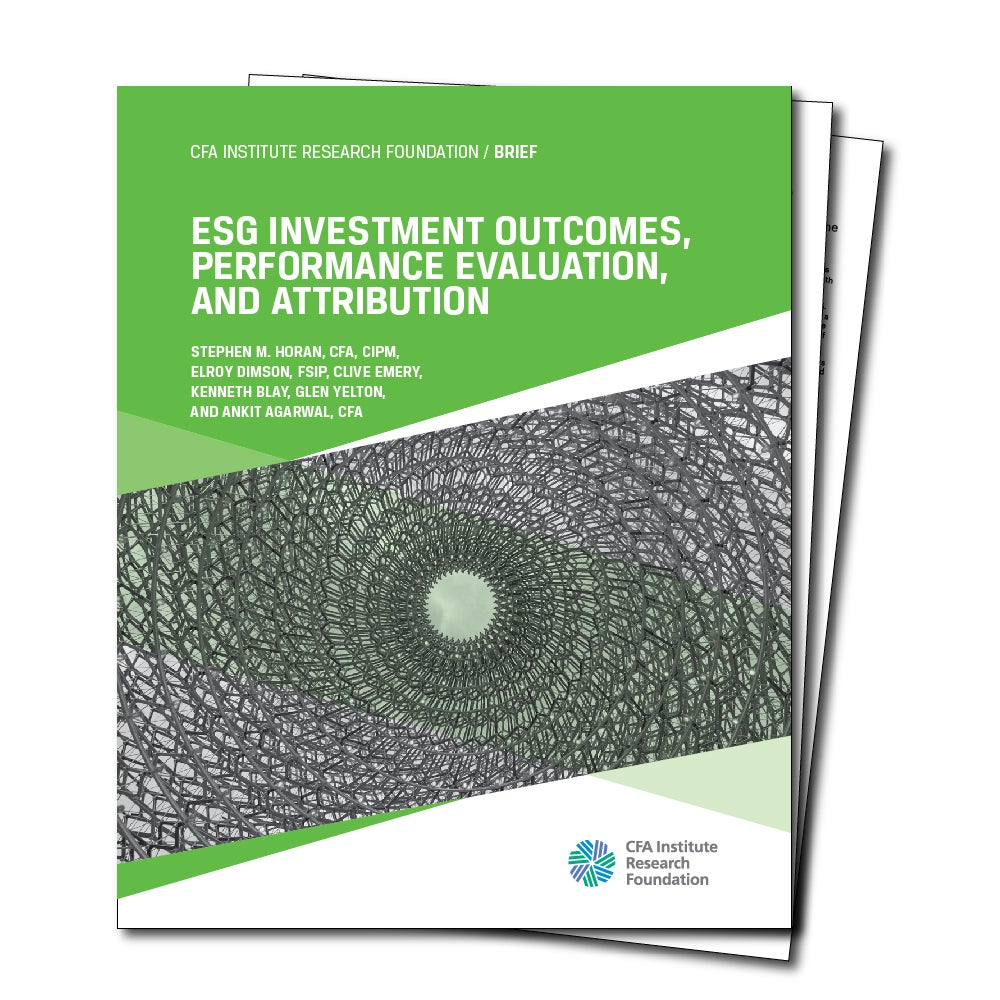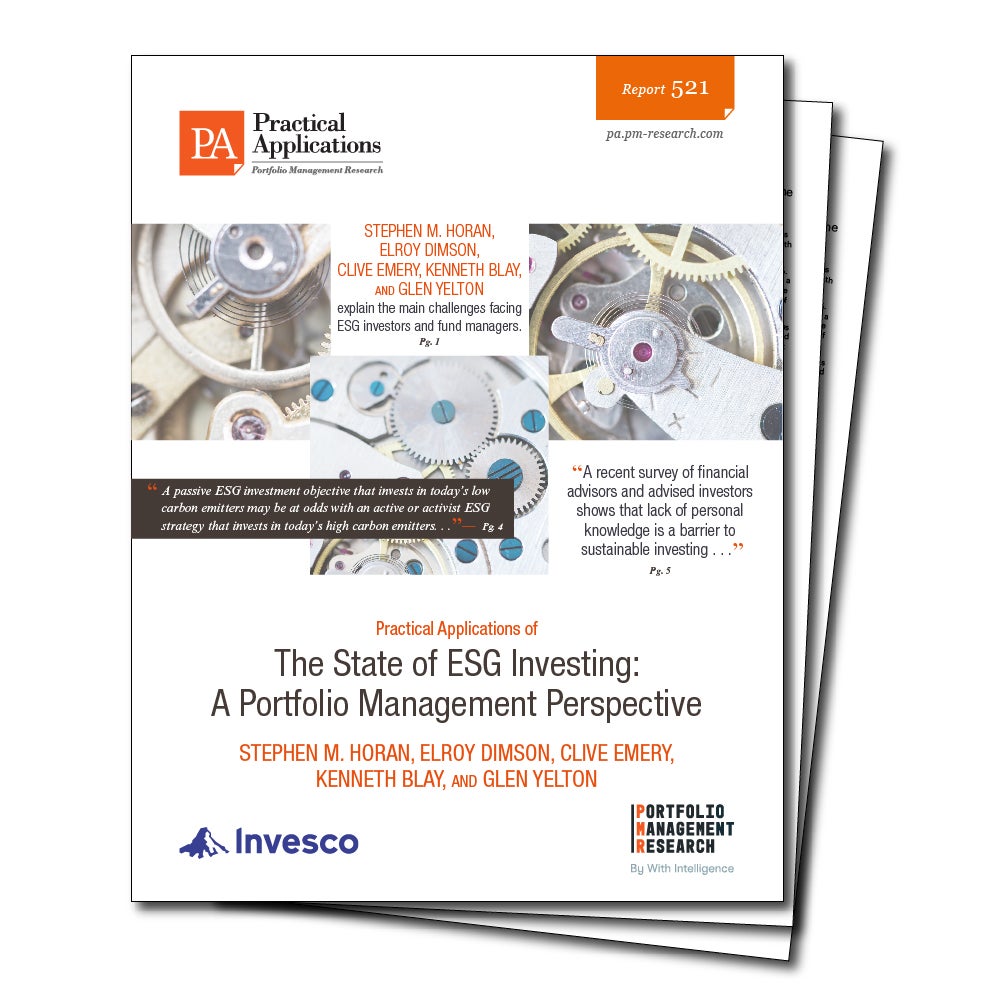
ESG Investment Outcomes, Performance Evaluation, and Attribution
This CFA Institute Research Foundation brief provides guidance on key challenges and proposes a performance evaluation and attribution framework.

Environmental, social and governance (ESG) strategies have seen massive inflows of capital over the past decade. Today, over one third of the world’s assets under management are ESG investments. And yet investors have little evidence that ESG investing accomplishes its purported goals. Nor do they have the information, tools, and methods they need to evaluate and communicate their specific ESG values, objectives, and preferences, much less to judge ESG performance.
A series of white papers highlight the challenges that ESG investors and portfolio managers face in implementing ESG investment mandates. These challenges are addressed with the end – the outcome – of ESG investing in mind. Because if ESG investing is to effectively make positive change, then outcomes matter.

ESG Investment Outcomes, Performance Evaluation, and Attribution
This CFA Institute Research Foundation brief provides guidance on key challenges and proposes a performance evaluation and attribution framework.

The State of ESG Investing: A Portfolio Management Perspective
This Journal of Impact & ESG Investing article gives an overview of the current state of ESG investing, highlighting the challenges faced by investors with ESG investment objectives and the obstacles confronting portfolio managers with ESG investment mandates.

Practical Applications Summary of The State of ESG Investing: A Portfolio Management Perspective
This Portfolio Management Research Practical Applications article provides a summary of The State of ESG Investing: A Portfolio Management Perspective
The demand for more corporate reporting on nonfinancial information is on the rise from regulators, standard setters, investment trustees, and consumers. Yet the industry has yet to coalesce around measures that capture the nonfinancial benefits of ESG.
All investors can be defined based on their willingness to make tradeoffs between financial and non-financial returns. But investors cannot make trade-offs without knowing the quantity and quality of what’s being traded. Therefore, to elevate ESG as an investment objective on a par with return and risk, ESG factors that increase risk-adjusted expected returns should be differentiated from those that do not.
To be useful, issuer ESG reporting needs to be relevant, reliable, and relatable -- all of which are addressed in the reporting framework. In addition, solutions are proposed for standardisation – perhaps the biggest challenge for sustainability reporting by corporate issuers – and aggregatability.
The research also examines current attempts to improve ESG reporting and arrive at a solution that is clear, concise, aligned with investor objectives, and aggregatable into portfolio-level information, while leaving intact investor values, which are subjective, individual, and not standardisable.
The heart of “The End of ESG Investing” is our proposed performance evaluation framework. R3 takes the Sharpe ratio, which captures risk and return, and adds responsibility – an additional term to the equation that allows investors to assess a portfolio’s ESG profile and to evaluate manager performance on this dimension. R3’s responsibility quotient is modified by an intensity factor that represents the weight, based on preferences, that an investor assigns to non-financial ESG goals.
To mitigate the vulnerability of the ESG quotient to manipulations such as window-dressing, R3 includes a transition measure that accommodates both ESG levels (“today’s virtue”) and ESG change (“tomorrow’s transition”), without taking a position on either. R3 also allows for ESG performance attribution to asset selection, security selection, and the interaction between asset and security selection. The research demonstrates all of these aspects of R3 with an example.
Developed more as a practical tool than as a rigorous model, R3’s advantages lie in its independent treatment of financial and nonfinancial components, its intuitiveness, and its generalisability to any measure of risk-adjusted performance. As a framework for investors to articulate their specific investment objectives, R3 is a major practical advance.
“The End of ESG Investing” also proposes a concise, standardised ESG product template for investment strategies with nonfinancial ESG investment mandates. Our template includes 1) fund objectives, including nonfinancial investment objectives; 2) elements of the ESG investment process; and 3) measurable nonfinancial investment outcomes.
As an alternative to ESG information disclosure patterned on a “truth in investing” document, our one- to two-page template should serve the same function for nonfinancial objectives as investment performance reporting does for financial objectives. It reflects our preference for fewer rather than more metrics, based on measurability and materiality – cutting down on confusion, maintaining clarity, and avoiding the need to define a multitude of weights.
Doing good while doing well is here to stay. Our aim for “The End of ESG Investing” is to identify and acknowledge the gaps in sustainable investing and contribute toward elevating it to the same professional standard as that of traditional investing. If we succeed as an industry in applying the same rigour to sustainable investing that we have applied to traditional investing in the last 100 years, we will have helped investors to actually do good.
This research aims to help the industry apply the same rigour to sustainable investing that it has applied to traditional investing in the last 100 years.

Net Zero Global Bonds: Supporting enablers in the journey to a low-carbon economy
Andy Byfield, looks at how our Net Zero Global Bond Strategies aim to invest in companies that are driving towards a sustainable future.

Climate investing: mitigation and adaptation
Climate change is challenging societies and to address the risks it’s essential we invest in mitigation and adaptation strategies. Find out more.

2023 UK Stewardship Code Report
Our 2023 UK Stewardship Code Report details how we're supporting good stewardship practices in the UK and beyond.
The value of investments and any income will fluctuate (this may partly be the result of exchange rate fluctuations) and investors may not get back the full amount invested.
This document is marketing material and is not intended as a recommendation to invest in any particular asset class, security or strategy. Regulatory requirements that require impartiality of investment/investment strategy recommendations are therefore not applicable nor are any prohibitions to trade before publication. The information provided is for illustrative purposes only, it should not be relied upon as recommendations to buy or sell securities.
Where individuals or the business have expressed opinions, they are based on current market conditions, they may differ from those of other investment professionals, they are subject to change without notice and are not to be construed as investment advice.